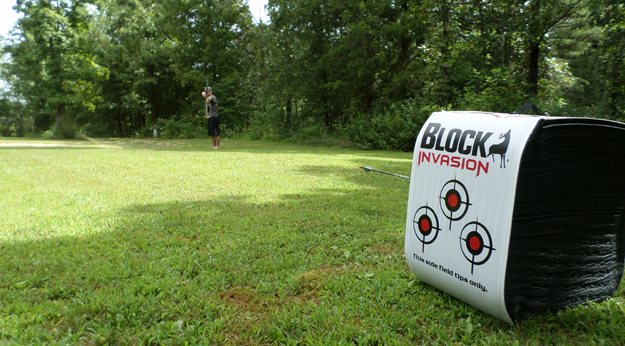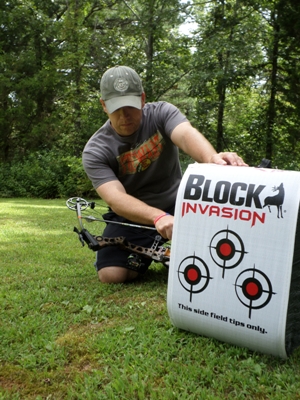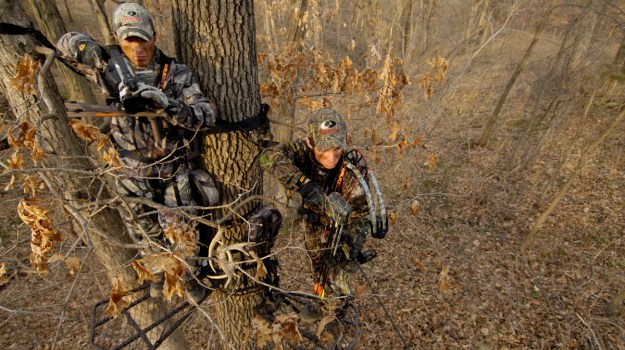by Heath Wood | Mossy Oak ProStaff

As a bow hunter, there is nothing worse than spending time scouting, putting up game cameras, and hanging tree stands only to miss when that moment comes and a big buck is under the stand. So it is incredibly important to practice with your equipment before the actual hunt. Not only could you miss the animal completely, but also you could make a bad shot resulting in an injured animal. I try to shoot my bow throughout the year, including the hot summer months of July and August. When the summer months arrive, I try to spend 4 or 5 days a week practicing with my bow. This practice gives me plenty of time to be at the top of my game when bow season arrives during the middle of September.
A few years back a buddy of mine shot competition archery and was also a die-hard bow hunter. He taught me a few tricks to be better prepared for bow hunting.
First, I needed to sight in my bow. When I began practicing for the upcoming season, he had me measure my distance with a tape measure to get that exact distant. I then sighted in four pins: a 20, 30, 40, and fifty yard sight pin. After that I began shooting several arrows at each distance until I was fine tuned into the bulls-eye. I use a block layered style target that has a good clear bulls-eye on it.
 Secondly, after making sure I had my bow shooting accurately at each distance, I changed up my practicing style to be more in tune with a bow hunter style instead of a competition shooter style. After switching to the bow hunter style, I never measure the distance when I'm shooting. I will not be able to stop a deer and measure the exact distance each time before I shoot, so becoming accustomed with the bow and sight depth is a must. I will shoot at random distances and in doing this it keeps me guessing at how far the animal is each time. This allows me to learn how my equipment shoots at 23, 25, 32 yards, etc. During this same technique I like to walk all different angles, as well. I'm not always straight ahead of the target. I like to do several quartering away shots at longer distances and at close range. Practicing every kind of shot that might be presented when a deer comes by your stand or blind is essential to your season.
Secondly, after making sure I had my bow shooting accurately at each distance, I changed up my practicing style to be more in tune with a bow hunter style instead of a competition shooter style. After switching to the bow hunter style, I never measure the distance when I'm shooting. I will not be able to stop a deer and measure the exact distance each time before I shoot, so becoming accustomed with the bow and sight depth is a must. I will shoot at random distances and in doing this it keeps me guessing at how far the animal is each time. This allows me to learn how my equipment shoots at 23, 25, 32 yards, etc. During this same technique I like to walk all different angles, as well. I'm not always straight ahead of the target. I like to do several quartering away shots at longer distances and at close range. Practicing every kind of shot that might be presented when a deer comes by your stand or blind is essential to your season.
Last, but not least, you must practice in a hunting situation. You're probably thinking, "isn't that what we just discussed?" What I mean is practice from your tree stand or your blind. I like to set my stand up in the edge of my yard or in the woods away from where I'm actually hunting. I will then shoot 4 or 5 arrows, retrieve them, and then move the target somewhere else. I will continue to climb back up and shoot repeatedly until I feel secure in my method. This type of practice will also give you a good workout. Shoot at different angles and cover all of the ways a deer could approach.
Another tactic I use to prepare for a hunting situation is to wear some of my hunting gear, such as a jacket, safety system, arm guard, hat, grunt call, and binoculars. This will get you familiar with everything you will be wearing when you're in a tree or blind hunting. If your preferred choice is a blind, try setting your blind up in the yard and shoot from all different angles and positions.
A few years back, on an early October bow hunt in southern Missouri, I had a doe walking directly behind my stand location. Just to see what she would do, I grunted on my True Talker grunt call. To my surprise, the doe stopped and started walking right to my location. I quickly grabbed my bow, and in just a few seconds she was directly under me. I decided to go ahead and fill one of my doe tags since she was so close. When I shot, the arrow went right over her back, and she jumped a few steps and then began walking up the hill beside me. I hurried to get another arrow ready, and when I looked up, she was at approximately 30 yards directly broadside. This time my arrow found its mark. Although I should have been excited for my harvest, I was aggravated that I missed at such a close range. This hunt was a perfect example and tell-tale sign that I had only been practicing at broadside shots. Now I practice all of the different angles and ranges.
One of the best feelings when hunting is when a plan comes together and you are successful. By taking a few minutes each night to practice your skills, your chances of completing that plan increase tremendously. I hope maybe you can take some of these tips that I have learned and make your hunts more successful.
Let us know what you do during the Summer Slump by sharing on our Facebook page and on Twitter and Instagram by mentioning @mossyoak with the hashtag #summerslump.



























